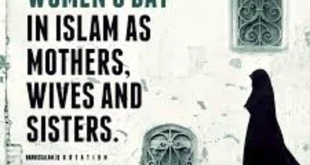As we know, the Islamic faith and culture are closely intertwined and related. Generally Islamic culture conforms to and evolves within the Islamic framework. This is because that particular culture community is a also a piously religious one and so religion and culture go hand in hand, the cultural aspect being understood to be well within the ambit of religion and not outside it. As good Muslims we know this has to be that way.
However is it possible for unislamic cultural practices to enter the faith community? The answer is impossible or next to impossible as we have seen above. But it is certainly possible that certain Islamic practices could with time evolve to assume an unislamic character that could impact negatively on the community, and especially on women. This is true of a number of practices that exist in Muslim communities today.
Thus the religious counsel that it is preferable for women to pray at home has evolved to the very unislamic idea that women should not be allowed to the mosque at all. This is despite the fact that the Prophet of Islam (Peace Be Upon Him) stated very clearly that “The handmaidens of Allah (ie.Muslim Women) are not to be prevented from entering the mosques if they wish to do so.
Similarly the Islamic commandment of Hijab that requires women to cover themselves from head to toe except for the face and hands has in some communities evolved to a state where women are compelled to cover up so completely that even their eyes are not visible, again in contrast to the Quránic injunction that enjoins women to cover up except that which is “apparent” and which also clearly presupposes a society where women do not necessarily have their faces covered, since it commands men as much as women to “lower the gaze””.
And now to another religious practice that has evolved in certain Muslim communities to take a rather unislamic form. That is Female Genital Mutilation (FGM), which involves removing a female’s clitoris and in some cases the labia minora and even sewing the parts together, all with the objective of curbing her sexual pleasure and preventing intercourse until such time she is married. This takes place in certain African countries and even in few parts of the Arab world. That this practice is in contravention of Islamic teachings no good Muslim would doubt. This is exactly why Islamic knowledge is so important to be shared at all times. It prevents Islam from being corrupted from within by extremist elements.
And now to the practice of female circumcision proper. All the early Islamic jurists were agreed that we have something called female circumcision in Islam, just as much as we have male circumcision. The only difference of opinion our classical scholars had was whether it was obligatory or prescribed or merely recommended, but let us remember there has been a difference of opinion with regard to the obligatory nature of male circumcision as well. The Shafi School of Law which the majority of local Muslims follow regards circumcision as obligatory and both male and female circumcision as obligatory which explains why it is more pervasive in some communities than others, for example among the Muslims of Sri Lanka and South India, Malaysia and Indonesia and Brunei, Egypt and Yemen and among the Kurds and Russian Muslims among many others.
That this practice is Islamic there can be no doubt, because numerous ahadith or sayings of the Prophet (Peace Be Upon Him) refer to it, some of it like the hadith on Fitra Practices and the Prophet’s command to some Medinan Women to “Be circumcised” being a very strong indicator of its obligatory nature, which is supported by the acts of his closest companions like his son-in-law Uthman who when he was Caliph ordered that even women who embraced Islam were to be circumcised and his wife Ayisha who arranged the procedure for her nieces as evident in that collection of ahadith known as Adab Al Mufrad by Imam Bukhari. In fact, there are more ahadith that specifically refer to female circumcision than male circumcision.
But is the female circumcision prescribed by Islam and FGM the same as argued by biased Western governments and organisations? The answer is a resounding NO. What the female circumcision prescribed in Islam involves is the removal of the prepuce or foreskin of the clitoris, which is analogous to the foreskin of males removed at circumcision. Could this be the same as FGM which which involves removing the clitoris itself among other things?
How can it be when FGM is meant to curb women’s sexual pleasure while the female circumcision prescribed in Islam has just the opposite effect, which is enhancing sexual gratification if the female, a fact indicated by the Prophet (PBUH) himself and now established by unbiased Western medical science, which is why even American women are choosing to undergo it under a procedure called hoodectomy and paying thousands of dollars for it. Would they elect to have the procedure and pay for it on top of it if it were harmful or did not yield the results they desired? The answer is pretty obvious.
In Sri Lanka we know that female circumcision is practiced by the vast majority of Muslims of Sri Lanka, be they Moor, Malay or Bohra. That the procedure followed is not FGM has been clearly established now. It is either the Islamically prescribed procedure of removing the clitoral foreskin as practiced in piously religious communities like Malaysia or else nicking it a bit to draw a little blood, which is a cheap substitute for the proper procedure. Although it falls short of what Islam requires and does not confer the benefit the Islamic procedure brings, it is nevertheless an innocuous practice.
Finally, we need to ask ourselves if female circumcision were indeed unislamic and a patriarchal imposition to the detriment of women, why would Muslim women support it?
Sometime ago, the FPA launched a report by Zainab Ibrahim and Ermiza Tegal ‘Towards Understanding Female Genital Cutting in Sri Lanka’ which has sought to make a somewhat balanced study of this issue. Although it has chosen to downplay the religious arguments for the practice, its health and sexual benefits and harmless nature, it has still sought to understand the practice from the perspective of women who have undergone it, and this is what is most important. Understand the other, without repeating hackneyed Western rhetoric about the subject.
So what do we have? – the practice is mostly supported and perpetuated by women, with nearly 90 percent identifying a female person as being the key influencer and reproducer of the practice (debunking the idea that its a patriarchal imposition); Besides, all respondents who had daughters, had them circumcised. One woman who had not been done, had it done on her daughter and another went so far as to tell her sons “If you have daughters, you should do this”.
Some compared their experiences in relation to their sons’ ‘circumcision’ and stated that they felt more disturbed by male ‘circumcision’ because they felt the male child experienced more hurt and were engaged longer in caring for them after their circumcision compared to their daughters. Therefore,in comparison, they felt ‘it was not so bad’ for the girl child. In speaking of the perceived impact of the practice many felt that it had no impact.
Interestingly, the women said they did not experience any impact on their lives, whether in terms of hygiene and sexual pleasure, and when it came to giving the reasons- It was perceived as a religious requirement, It was perceived as a means of establishing a ‘Muslim identity’, It was believed to be medically beneficial, It was perceived as improving sexual experience of the woman, It was perceived as improving the appearance of female genitalia,It was perceived as improving sexual partners interest, which all these women regarded very positively.
And most importantly these women expressed an interest in medicalising the procedure and training traditional practitioners to do it right.
The moral- Understand the other and respect their religious beliefs. Most importantly respect the women who choose to practice their religion the way they understand it without imposing one’s biased Western interpretations on them.
 Sri lanka Muslims Web Portal Diversity and Inclusiveness
Sri lanka Muslims Web Portal Diversity and Inclusiveness



